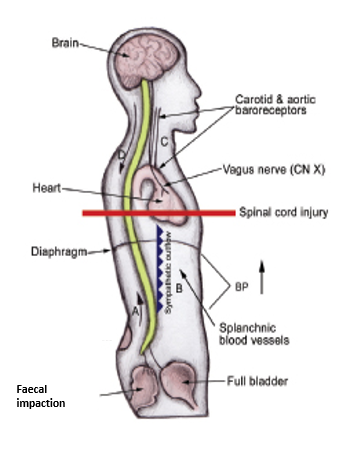What to do if AD is suspected
 Autonomic dysreflexia (AD) is a potentially life-threatening medical emergency:
Autonomic dysreflexia (AD) is a potentially life-threatening medical emergency:
-
- AD can occur in patients with spinal cord injury at or above the 6th thoracic vertebra (T6).
- It is more likely to occur in patients with complete injuries, but incomplete injured patients can also be at risk.
- The condition is triggered by a painful stimulus below the level of the injury which causes severe, sudden hypertension (raised blood pressure),
and if left untreated can be harmful - For most people, AD can be easily treated as well as prevented.
The key is knowing your baseline blood pressure, triggers and symptoms.
NOTE: Medications are generally used only if the offending trigger/stimulus cannot be identified and removed – or when an episode persists even after removal of the suspected cause.
What to do if AD is suspected:
-
- Most importantly, locate and remove the offending stimulus, if possible.
Early recognition of the condition is essential so that treatment can be started immediately. - Begin by looking for your most common causes: bladder, bowel, tight clothing, skin issues.
- Most importantly, locate and remove the offending stimulus, if possible.
NOTE: Keep in mind that when you remove the cause, your AD may get worse before it gets better.
Then follow these steps:
-
- Sit up or raise your head to 90 degrees
If you can lower your legs, do so - Loosen or remove anything tight
- Treat the cause
- Not everyone has access to a blood pressure (B/P) machine but if you can, check blood pressure every five minutes.
NOTE: It is more important to treat the cause first when you are dysreflexic, than trying to get a blood pressure reading.
In adults with a cervical level (neck) injury who often have low blood pressure, a rise in systolic (upper) blood pressure of 20 – 40mmHg (which may bring your B/P within the normal range) may indicate AD.
For other patients a systolic (upper) B/P of 150mmHg or more is an indicator of AD.
Make sure you know YOUR normal resting blood pressure (see below*) - Stay sitting up until blood pressure is normal
- Sit up or raise your head to 90 degrees
Seek prompt medical advice if the cause cannot be identified, or the hypertension cannot be controlled.
Tell the doctors and nurses/paramedics/ambulance crew that you:
-
- may have Autonomic dysreflexia (AD)
- need to find what’s causing it
- need to have your blood pressure checked
- need to stay sitting up
NOTE: If the hypertension is severe, or the cause still cannot be identified, you will need to be treated with medication.
Medications are generally used only if the offending trigger/stimulus cannot be identified and removed – or when an episode persists even after removal of the suspected cause.
Medications are generally used only if the offending trigger/stimulus cannot be identified and removed – or when an episode persists even after removal of the suspected cause.
You or your carer must carry medication and other supplies to treat the causes of AD at all times.
- Medicines that can be used include nifedipine capsules, glyceryl trinitrate (GTN) tablets or spray, and captopril.
- (If you use medication to treat erectile problems GTN may not be suitable for you to use as it lowers the B/P further).
- Your doctor and pharmacist will advise you what dose should be taken and how to give the medicine.
- Check regularly that your medication is not out of date.
If medicines have been taken, continue to monitor B/P (if you can), pulse rate and symptoms (* See below for more information)
- every 5 minutes until B/P returns to normal
- then every 15 minutes for 1 hour.
* Know your normal resting blood pressure
- It is important that you are aware of, and have written down your normal resting blood pressure.
- This will help to identify whether your blood pressure is higher than normal for you.
The following blood pressure readings may be a sign of autonomic dysreflexia (* Hg is chemical sign for mercury and how B/P is measured):
20mmHg to 40mmHg above baseline in adults
15mmHg above baseline in children
15mmHg to 20mmHg above baseline in adolescents
Some of the signs of AD include:
- high blood pressure
- pounding headache
- flushed face
- sweating above the level of injury
- goose flesh below the level of injury
- nasal congestion
- nausea
- a slow pulse (slower than 60 beats per minute)
Autonomic Dysreflexia is caused by an irritant below the level of injury, often related to bladder or bowel, such as:
- irritation of the bladder wall, urinary tract infection, blocked catheter or overfilled collection bag or full bladder
- distended or irritated bowel, constipation or impaction, haemorrhoids
Other causes include:
- skin problems, pressure ulcers, ingrown toenails
- burns (including sunburn or hot objects and scalds from hot water)
- tight or restrictive clothing
- AD can also be triggered by sexual activity, menstrual cramps, labour and delivery, ovarian cysts
- abdominal conditions (eg gastric ulcer, colitis, inflammation of the gallbladder or appendicitis )
- bone fractures or sprains